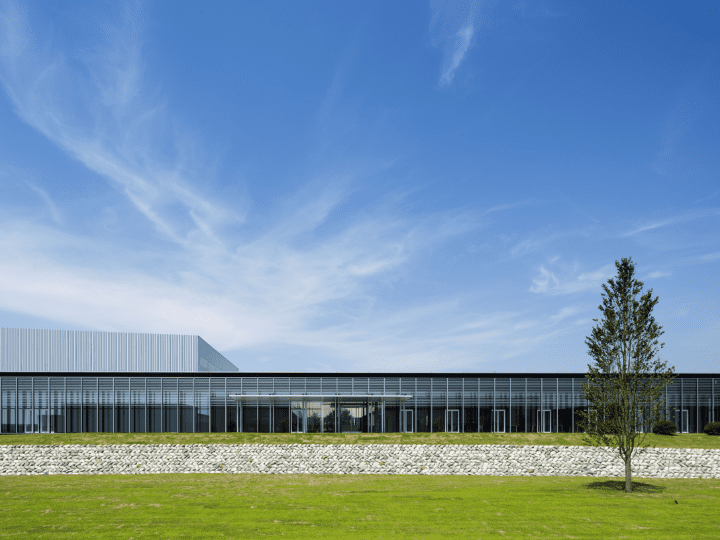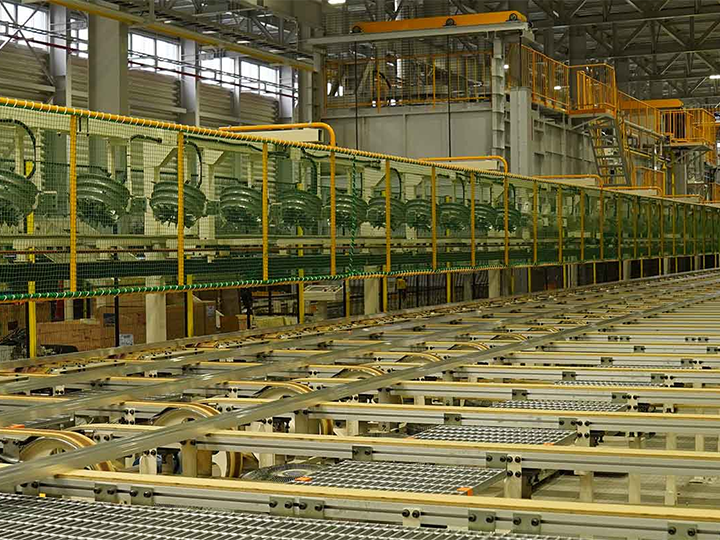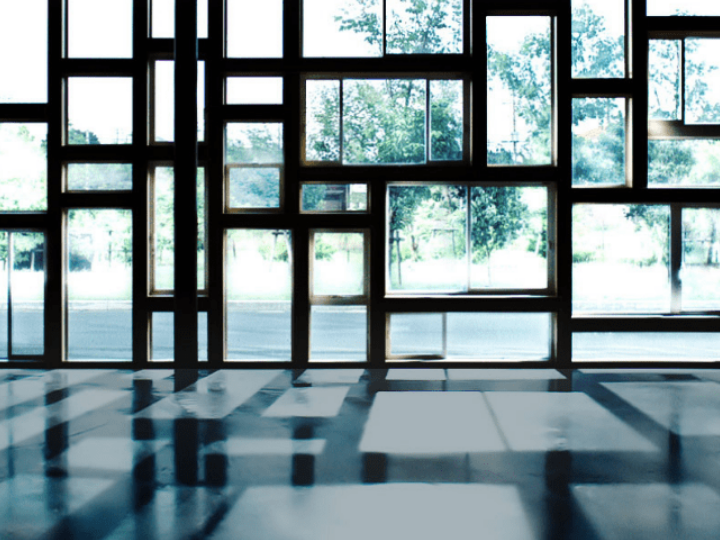
Stop the Landfill Disposal of Used Vinyl Windows! Disseminating Vision for Vinyl Window Recycling Through Industry-Government-Academia Collaboration, and Taking on the Challenge of "Window-to-Window" Recycling
“We Build a Better Society Through Architectural Products.” This is YKK AP’s Purpose and the meaning of our existence—building a better society—as we conduct our business of developing, manufacturing, and selling windows, doors, interior and exterior architectural products, curtain walls, and other items. We would like to introduce YKK AP's efforts to recycle vinyl windows with frames made of vinyl, which are processed in the market, through industry-government-academia collaboration.
With the aim of making a carbon neutral society a reality, the architectural products that YKK AP handles are also required to have high added value and top performance to address environmental issues. One example is vinyl windows with excellent thermal insulation performance, which contribute to reduced everyday energy consumption for residential homes and buildings. In order to spread awareness of the benefits of vinyl windows, such as their high thermal insulation performance and energy-saving effects, we have been continuously holding forums and seminars for professional users throughout Japan since 2012. Currently, the rate of vinyl window use in Japan (*1) has increased to 29% (FY2022), while YKK AP has a rate of conversion to vinyl windows (*2) of 36% (FY2023 estimate), contributing to nationwide promotion of vinyl windows by expanding sales.

Vinyl windows: APW 330
At the same time, from the viewpoint of resource recycling, we are making an effort to recycle vinyl materials which are generated when the products are manufactured and after they have been used. As for recycling during manufacturing, we are increasing the recycling rate of vinyl scraps generated by the manufacturing process, and are enhancing efforts to recycle vinyl materials for windows and gaskets (*3) with the goal of achieving 100% recycling by FY2024. (*4)

(Left) Vinyl scraps generated by the process of manufacturing vinyl windows
(Right) Vinyl profiles made from recycled raw materials obtained from vinyl scraps (gray sections are recycled materials)
On the other hand, the majority of Japanese vinyl windows distributed in the market are currently disposed of in landfills, without being recycled. To solve this pressing issue, the Vinyl Window Recycling Committee, organized mainly by industry associations related to vinyl windows, is working toward the implementation of recycling through industry-government-academia collaboration. To learn more about YKK AP's efforts to establish recycling technology in cooperation with the committee, we interviewed Ms. Akiko Ichikawa, a member of the Environmental Management Office of the Safety & Environment Department at YKK AP, and is currently studying vinyl window recycling at a graduate school at The University of Tokyo after being sent to do so by the company.

Ms. Ichikawa
Stop the Landfill Disposal of Used Vinyl Windows!
Research and studies on the recycling of used vinyl windows—led by Professor Tsuyoshi Seike of The University of Tokyo, the leading expert on vinyl window recycling—have been conducted since the early 2000s, and various verification studies have been done. One of the reasons it took time for full-fledged recycling activities to begin was that as the use of vinyl windows became more widespread after the 1980s, especially in Hokkaido, a cold climate region, it took several years until efforts to dismantle installed vinyl windows gained momentum, and the amount of collected material increased. In addition, for used vinyl windows, there were many challenges in terms of technology, cost, and mechanisms at each stage of dismantling, recovery, conversion to recycled raw materials, and recycling.
With the spread of vinyl windows, the amount of used vinyl windows is expected to increase in the future. In August 2019, industry organizations formed a unified front and established the Vinyl Window Recycling Committee in order to reduce the amount of vinyl windows disposed of in landfills. The study committee is chaired by Professor Seike and includes domestic window manufacturers, including YKK AP, as committee members, with the Vinyl Environmental Council, the Japan Sash Manufacturers Association, and the PVC Windows Industries Association serving as secretariat. Mr. Toru Inaba, a technical advisor for materials technology at YKK AP, is involved with the committee as vice-chairman, and I am also participating in demonstration experiments as a member of the Seike Laboratory at the Graduate School of Frontier Sciences of The University of Tokyo, where I am an observer. There are also employees who are on temporary assignment at some associations, so YKK AP is involved in the committee from multiple perspectives: the standpoints of the company, the university, and the associations.

Vinyl Window Recycling Study Committee Chairman Seike (third from left) and the YKK AP employees on the committee
Study of Used Vinyl Windows (Initiative by the Vinyl Window Recycling Committee)
Using Hokkaido—which has produced vinyl window waste matter ahead of other regions—as a model case, the committee aims to establish a recycling system that includes regions south of the Tohoku region, where there are many aluminum-vinyl composite windows. In this study, while making reference to European cases and existing studies, each of the committee members and observers have been working together in three phases: conducting surveys on the disposal of vinyl windows (FY2019-2020), conducting recycling demonstration experiments (FY2021-), and preparing for social implementation (FY2023-).
In the recycling demonstration experiments, various experiments and verifications are conducted using used vinyl windows that were actually dismantled in Hokkaido. As the combination of components in vinyl windows has accelerated due to high airtightness and thermal insulation, they have been becoming more complex. Therefore, in order to understand the initial state of what adheres to dismantled and collected vinyl windows, the Seike Laboratory at the University of Tokyo collected data on foreign matter which adheres to used vinyl windows. As a result, the laboratory found that a wide variety of foreign matter, including metal and vinyl components, as well as wood and exterior materials from frames, would get attached to the windows.

(Left) Used vinyl window frames collected on a trial basis
(Right) Examples of foreign matter (Left: gasket, Middle: reinforcing material, Right: sash roller)
Next, the team experimented with the recycling process to see if foreign matter adhering to vinyl windows could be removed. In addition to the conventional recycling process done with factory scraps, magnetic sorting, visual sorting, and manual sorting using mesh trays were also added to the process and verified. As a result, the experiments revealed that various foreign materials were mixed into the contents of the recycled raw material flakes (*5).
In vinyl window recycling, the inclusion of materials other than the main component, polyvinyl chloride (PVC), can lead to appearance defects and performance degradation. Because of this, ensuring the high quality of recycled raw materials is essential for stable recycling. Recycling technology that enables the proper use of recycled raw materials must be established.

(Left) Used vinyl window frames being fed into a device (*6)
(Right) Experimenting with removing metal through magnetic sorting (*6)

(Left) Recycled material being collected after being treated and discharged from the device (*6)
(Right) Studying the foreign matter contained in recycled raw materials
Taking on the Challenge of Recycling Windows into Raw Materials (Initiative by YKK AP)
Based on these results, YKK AP conducted tests to evaluate the physical properties of the resulting recycled raw materials, as well as experiments to create samples of vinyl window frames by extruding vinyl profiles made from the recycled raw materials.
The tests assessed the materials’ physical properties, expansion/contraction and surface changes during heating, and weather resistance performance, and measured them in accordance with JIS (Japanese Industrial Standards) and the in-house standards used for window profiles. The results confirmed that the materials meet the standard values. On the other hand, the recycled raw material flakes contained many foreign substances such as nylon resin, rubber, and metal. We found that additional sorting treatment was essential to remove this foreign matter.

Surface of a sheet made from the obtained recycled materials (encircled white or black spots are foreign matter)
In addition, to obtain higher quality recycled raw materials, we investigated suitable methods for material separation of used vinyl windows, referring to examples in Europe, which has made more progress with vinyl recycling. As a result, we found that electrostatic separation methods and optical sorting methods were effective in removing foreign matter.

(Left) Experiment to separate foreign matter from recycled materials
(Right) Recycled raw materials obtained from experiments to separate foreign matter
Next, we experimented with extruding vinyl profiles using recycled raw materials and creating samples of vinyl window frames. There were no issues with the dimensions or appearance of the extruded profiles. Even when it came to cutting during finishing and the joining process for window corner parts, it became clear that their quality was equivalent to that of recycled raw materials made from virgin materials (new vinyl materials) or scraps produced in-house. We are also conducting additional processing to completely remove foreign matter for even higher quality, as well as verification for stable production.

(Left) Vinyl window frames (From left to right: virgin materials, recycled materials from in-house scraps, recycled materials from used vinyl windows)
(Right) Vinyl window frames made of recycled raw materials from used vinyl windows, the joining process for corner parts
These efforts have paved the way for window-to-window recycling, in which recycled materials are collected from used vinyl windows and used to manufacture vinyl windows once again.
Social Implementation of Vinyl Window Recycling
In order to implement the mechanism of the recycling system into society, the committee disseminated vision for vinyl window recycling on January 9, 2024, declaring its intention to popularize vinyl windows to promote energy conservation in homes, increase resource recycling and reduce the final amount of waste products that are disposed of, and contribute to reducing CO2 emissions during manufacturing by utilizing recycled materials.
While there are many issues to be addressed in the future to achieve our goals, such as examining recycling organizations, building collection systems, constructing reprocessing lines, and establishing quality standards and criteria, the fact that this Vision could be declared thanks to the united efforts of industry, government, and academia, as well as the efforts of the industry as a whole, is quite impressive. I feel that a single company would not have been able to move forward with implementing demonstration experiments to this extent. Going forward, it will be necessary to expand the circle of understanding and cooperation to go from landfill disposal to recycling. In the future, we would like to systematize the know-how we have gained from surveys and expand the recycling system nationwide.

A regular meeting of the Vinyl Window Recycling Committee
YKK AP has established "Contribute to the Global Environment" as a policy in the "Evolution 2030" Vision. To that end, we are carrying out activities to reduce environmental burdens with the aim of realizing a decarbonized and circular society. Taking this Vision declaration into account, we will proactively accelerate our vinyl window recycling efforts as a vinyl window manufacturer. We aim to commercialize window-to-window recycled products using recycled materials derived from used vinyl windows, including those of other manufacturers, by the end of FY2024. YKK AP would like to actively take on the challenge of "achieving zero environmental burdens within our business activities throughout entire product life cycles."
*1: Survey about construction material used for houses, conducted by the Japan Sash Manufacturers Association
*2: Ratio of windows for detached houses to the number of sets sold
*3: Components for attaching glass to window frames without creating gaps
*4: The Japan Partnership for Circular Economy (J4CE) lists specific initiatives on its website
(1) Recycling scraps from cutting vinyl window frames
https://j4ce.env.go.jp/en/casestudy/160
(2) Recycling dark-colored vinyl window frame materials
https://j4ce.env.go.jp/en/casestudy/162
*5: Small and thin shapes
*6: Photos from lecture summaries and reports by the Architectural Institute of Japan (AIJ) in FY2022 and FY2023 are used

Akiko Ichikawa
Joined the company in 2001. In charge of performance testing and component analysis of aluminum and vinyl materials in the Performance Evaluation Office (now the Quality Management and Technology Office) of the Profile Technology Department. After transferring to the Environmental Management Office of the Safety & Environment Department in 2008, she worked on planning and promotion of chemical substance management policies in a leadership role. In 2020, she entered a doctoral program of the Graduate School of Frontier Sciences at The University of Tokyo (Seike Laboratory), where she is applying herself to research into the recycling of vinyl windows.
Share this article
- SNS Link X X Share
- SNS Link Facebook Facebook Share
- SNS Link LinkedIn LinkedIn Share
- SNS Link LINE LINE Share
- Copy Link Copy Link Copy Link Copied Link
Related stories
-

Toward Achieving Carbon Neutrality: Taking on the Challenge of 100% Aluminum Recycling by a Window Manufacturer
- Technology
- Manufacturing
- Environment
- Sustainability
-

The Evolution of the Aluminum Profile Department into the Automotive Industry’s Manufacturer of Choice
- Aluminum Profile
- Technology
- Sustainability
- Solving Social Issues
-

An integrated production system: a commitment to manufacturing that pays attention to even a single screw
- Technology
- Manufacturing
- Story of Development








